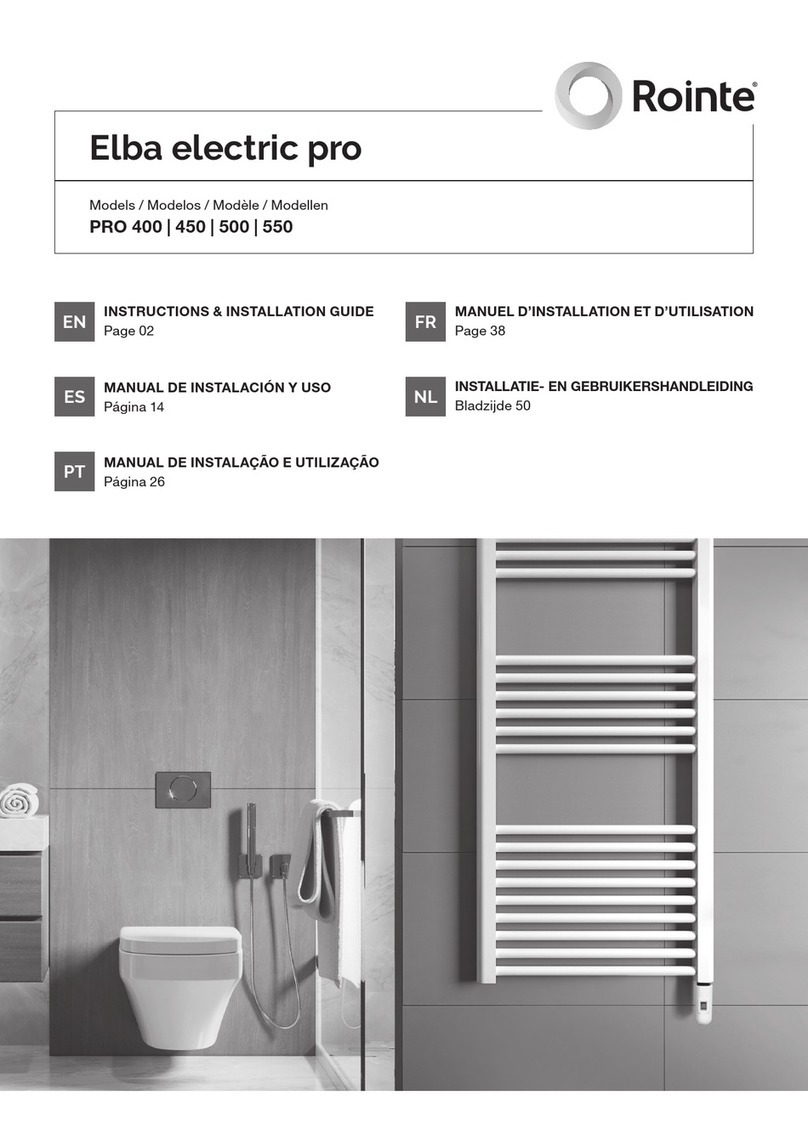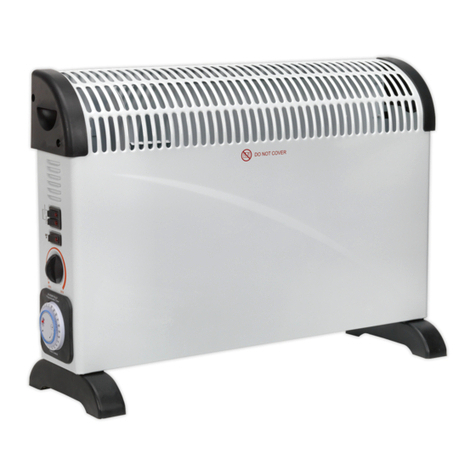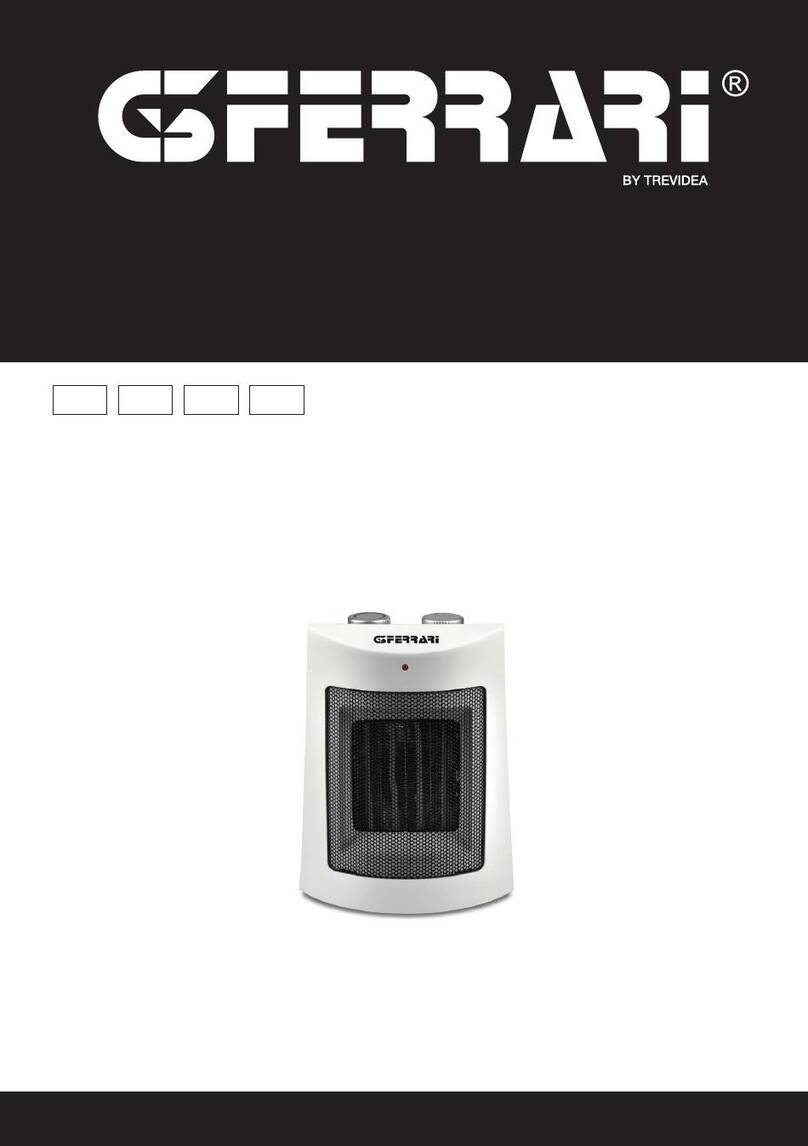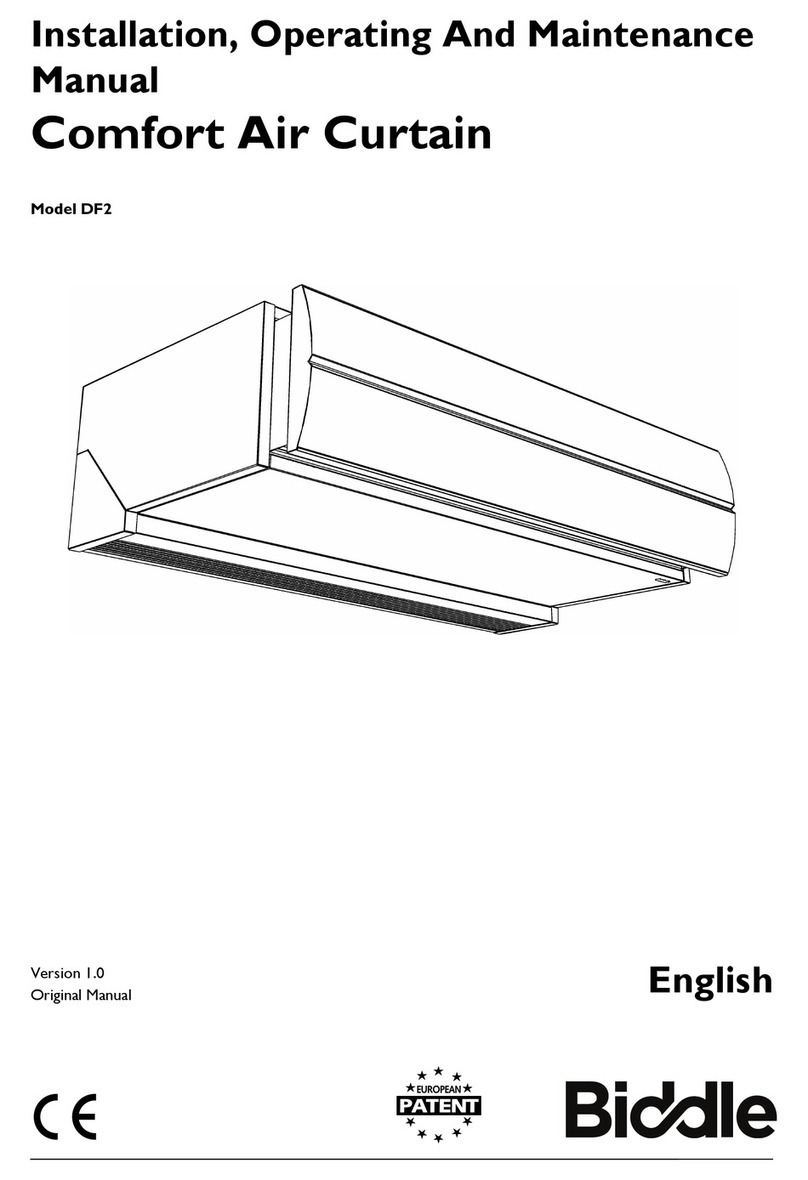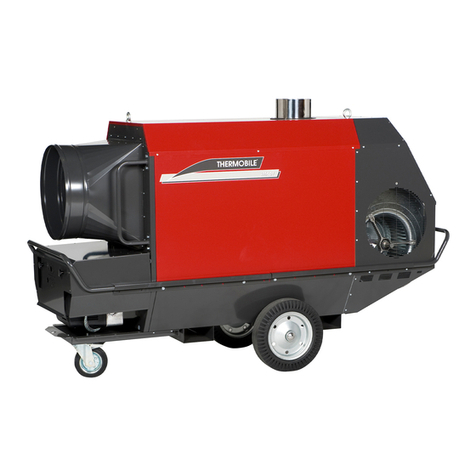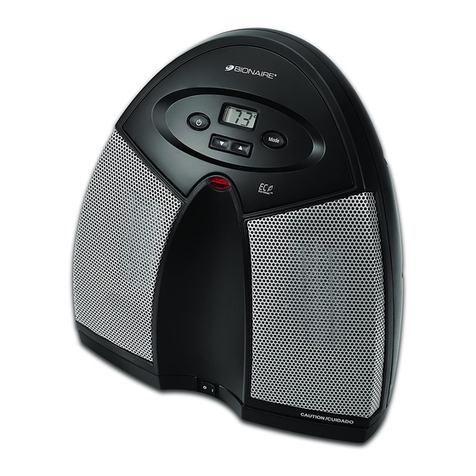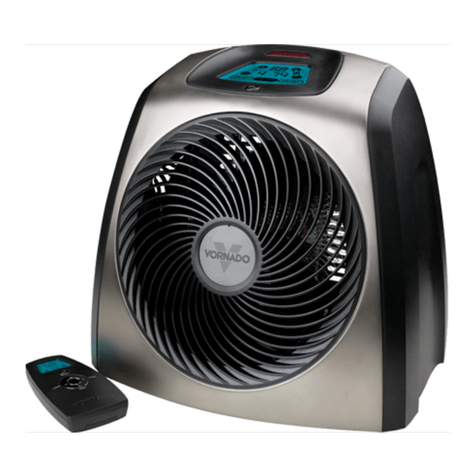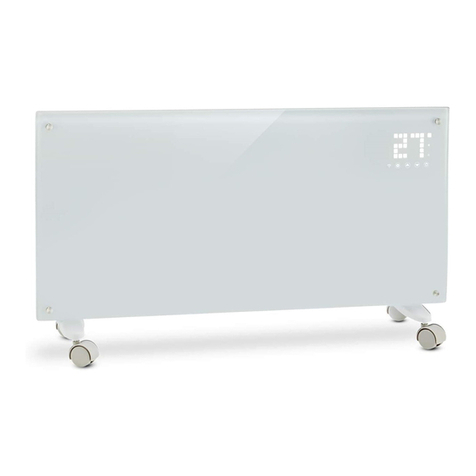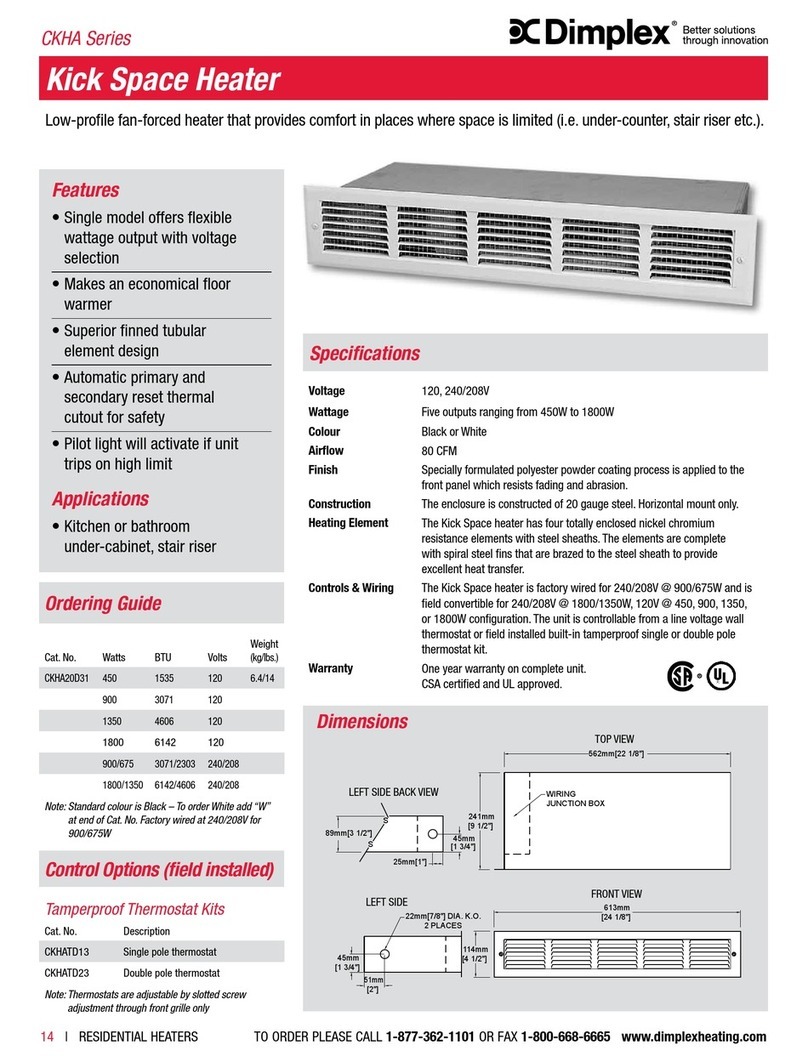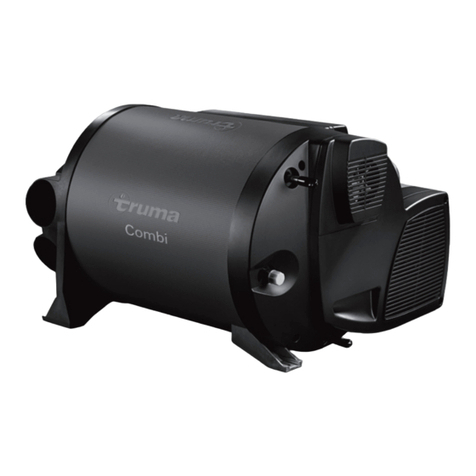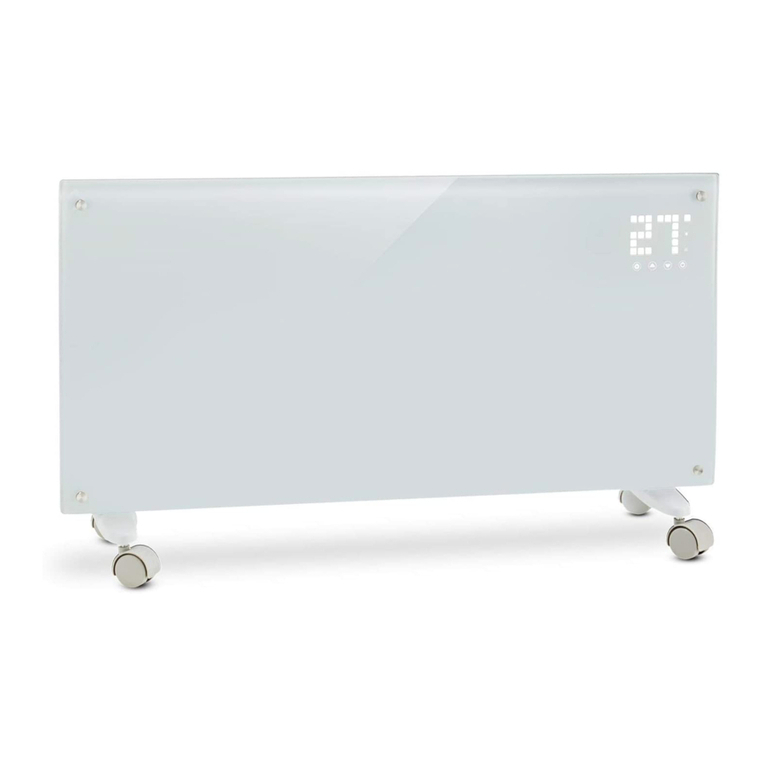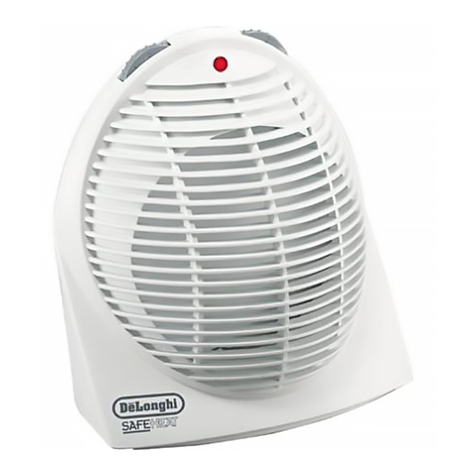Ventmatika EKA Instruction manual

Technical data
Mounng
Maintenance
ELECTRICAL CIRCULAR DUCT HEATERS
EKA
e
n
s
t
s
h
C
g
i
l
t
a
r
s
i
s
A
D

The electrical heater's model and serial number are located on the label of the product.
Improper use of this heater can result in serious bodily injury due to hazards of fire and explosion,
burn and electrical shock.
Use only with electrical voltage and frequency specified on model label. Do not perform any service
with heater plugged in. Serious injury or death may occur if personnel come in contact with high
voltage lead.
Parts of the heater become very hot when operang and immediately aer operang. Severe burns
may occur if the heater is not allowed to cool down properly before servicing.
WARNING! SAFETY REQUIREMENTS
All products are packed by producer for normal transporng condions. For unloading and storing
use proper lier to prevent product damage and employees injuries. Do not li product by power
supply cable, connecon box. Avoid impacts and impact loads.
Unl final installaon store products in dry place with humidity not more 70% (20°C), average
ambient temperature must be 5-40°C. Storing place must be covered from water and dirt. Avoid long
term storing. It is not recommended to store products more then 1 (one) year.
TRANSPORTING AND STORING
Inspect heater for any possible shipping damage. Inspect heater element wire for any deformaon
that could cause a short circuit or ground. Make sure that casing of the heater is not damaged.
RECEIVING AND HANDLING
No special service is required for electrical heaters, only to check electrical connecon not less than 1
me per year.
SERVICE
We care about quality. 100% of heaters are tested before shipment.
QUALITY
Important environmental informaon about this product.
This symbol on the device or the package indicates that disposal of the device aer its lifecycle could
harm the environment. Do not dispose of the unit as unsorted municipal waste; it should be taken to a
specialized company for recycling. Respect the local environmental rules.
If in doubt, contact your local waste disposal authories.
DISPOSAL
2
Thank you for your purchase of this product. This manual describes how to use and install the
supplied product. Be sure that you have read and understood its contents before using the heater.

Table of contents
Descripon
Installaon and electrical connecon
Dimensions
Technical data
Model marking
Overheang protecon
Heaters EKA with integrated controller
Descripon of operang EKA NV …
Descripon of operang EKA NI …
Descripon of operang EKA NIS …
Descripon of operang EKA NV … (PTC…PS)
Descripon of operang EKA NI … (PTC…PS)*
Descripon of operang EKA NIS … (PTC…PS)*
Descripon of operang EKA NV … 2NTC*
Descripon of operang EKA NI … 2NTC*
Descripon of operang EKA NV … PTC/2NTC*
Descripon of operang EKA NI … PTC/2NTC*
Service
Troubleshoong
Warranty
3
4
5
7
8
10
11
11
11
11
12
12
12
13
13
13
14
14
15
15
15

Descripon
Electrical duct heaters EKA are designed to heat fresh air in venlaon systems. Casing (EKA protecon class IP
44, except EKA Type NV which protecon class IP 30) is made from Aluzinc coated steel which is high temperature
proof and with rubber seals for duct connecon. Tube of heang element is made from stainless steel AISI 304.
There are 2 protecon thermostats and screw terminals for easy connecon installed in the heaters.
Heaters can be installed horizontally with the electrical connecon box facing upwards or sideways and
vercally (only if the air flow direcon upwards). Heaters can't be installed in explosive and aggressive substances
environment. Heaters can be used only for the clean air heang or preheang. Heaters intended only for inside
installaon. If heater is installed in such way that can be accidental contact with heang elements, protecve grill
must be installed. The air velocity in the duct of the heater must be 1,5 m/s minimum. The maximum temperature
of the output is 50 °C.
Heaters EKA with integrated temperature controller EKR-K… (See Fig. 1) can be controlled in five different ways
depending on control type:
Type EKA NV – potenometer on the lid of the heater (See page 11).
Type EKA NI – external wired remote setpoint knob (TR5K) for temperature control (See page 11).
Type EKA NIS – external wired remote 0…10V signal for temperature control (See page 12).
Type EKA ESKM – external wired remote PWM (ON/OFF: ON(6…24)VDC) signal for temp. control
Electrical duct heaters EKA with integrated temperature controller EKR-K… works by PID regulator. That enable
fine temperature control. Controller EKR-K… controls load by Triacs without moving parts, which causes no-noise
commutaon.
Fig. 1
4
View may vary depending on type EKR-K.

Installaon and electrical connecon
Electrical duct heaters EKA can be installed horizontally in any posion except electrical connecon box
downward and vercally (only if the air flow direcon upwards) (see Fig. 2).
IMPORTANT:
The installaon to the mains power supply may only be wired by a competent electrician. The power
supply cable must be selected in the rao with power of the heater. When installing these heaters, the
standards and regulaons in force in your country must be followed strictly adhered to. Within the installaon
an electrical isolaon automac circuit breaker (not included) must be present, to enable the installer to cut all
power supply lines. Automac circuit breaker must be selected regarding power and nominal current (see the
electrical rang plate on the lid of heater) of the heater and should have characterisc B. Connect the heater to
the mains power supply, check that the voltage, frequency, power and current are the same as those indicated
on the electrical rang plate. The heater must be earthed.
We recommend install supply air temperature sensor in distance mulplied by the heater's diameter (3xD).
For example: heater EKA diameter 200 mm, sensor's installaon distance will be: 3x200=600 mm.
Fig. 3. Mounng example EKA NV/NI…
*- TR5K is used in EKA NI heater version.
**- Temperature set point knob is used in EKA NV heater version.
Fig. 2
Fig. 3
5

Fig. 4. Mounng example EKA NIS/ESKM…
*- External control signal (0…10VDC) is used in EKA NIS type heater.
**- External PWM control signal ON/OFF: ON (6…24VDC) is used in EKA ESKM type heater.
Fig. 5. Mounng example EKA NV/NI…2NTC…
*- Temperature set point knob and TR NTC10 are used in EKA NV 2NTC heater version.
**- TR5K NTC10 is used in EKA NI 2NTC heater version.
Fig. 6. Mounng example EKA NV/NI… (Preheater)
**- TR5K used only in EKA NI pre-heater version.
*- Temperature set point knob used only in EKA NV pre-heater version.
Fig. 4
Fig. 5
Fig. 6
AHU – Air handling unit
6

Dimensions
Fig. 7. Mounng example EKA NIS/ESKM… (Preheater)
*- External control signal 0…10VDC (from AHU if possible) is used in EKA NIS type pre-heater.
**- External PWM control signal ON/OFF: ON 6…24VDC (from AHU if possible) is used in EKA ESKM type pre-
heater.
Fig. 7 AHU – Air handling unit
Fig. 8
Type 1 Type 2 Type 3 Type 4
Type 1 – Standard EKA heater dimensions;
Type 2 – EKA heater with external pressure relay dimensions;
Type 3 – EKA heater with external cooling radiator dimensions;
Type 4 – EKA heater with external cooling radiator and pressure relay diemensions.
7

EKA 250-15kW 250 265 3~400 15,0 1,0/1,5
EKA 315 315 425
1~230 0,6...9,0 0,6/1,0/1,2
2~400 1,0...9,0 1,0/1,5
3~400 3,0...9,0 1,0/1,5
EKA 500-15kW 630 532 81 500
EKA 500-18kW 630 532 81 500
EKA 500-21kW 770 672 81 500
EKA 500-24kW 880 782 81 500
Heater type A(mm) B(mm) C(mm) D(mm)
EKA 100 370 276 71 100
EKA 125 370 276 71 125
EKA 150 370 276 71 150
EKA 160 370 276 71 160
EKA 200 370
276
71
200
EKA 250 370
276
71
250
EKA 250-12kW
500
402
71
250
EKA 250-15kW
630
532
71
250
EKA 315 373
276
71
315
EKA 315-12kW
500
402
71
315
EKA 315-15kW
630
532
71
315
EKA 315-18kW
630
532
71
315
EKA 355 373
276 71 355
EKA 355-12kW
500
402 71 355
EKA 355-15kW
630
532 71 355
EKA 355-18kW
630
532 71 355
EKA 400 373
276
81
400
EKA 400-12kW
500
402
81
400
EKA 400-15kW
630
532
81
400
EKA 400-18kW
630
532
81
400
EKA 400-21kW
770
672
81
400
EKA 400-24kW
880
782
81
400
EKA 450 373
276
81
450
EKA 500 373
276
81
500
EKA 500-12kW 500 402 81 500
Technical data
EKA ø(mm) Min. airflow
(m³/h)
Power supply
(VAC/50Hz)
Power
(kW)
Available
heatng
elements (kW)
EKA 100 100 45 1~230 0,3...1,8 0,3
EKA 125 125 70 1~230 0,3...3,6 0,3/0,6
EKA 150 150 100 1~230 1,2...3,0 0,6/1,0
EKA 160 160 110
1~230 0,3...7,2 0,3/0,6/1,0/1,2
2~400 1,0...6,0 1,0
3~400 3,0...6,0 1,0
EKA 200
200
170
1~230
0,3...7,2
0,3/0,6/1,0/1,2
2~400
1,0...6,0
1,0
3~400
3,0...9,0
1,0/1,5
EKA 250
250
265
1~230
0,3...7,2
0,3/0,6/1,0/1,2
2~400
1,0...9,0
1,0/1,5
3~400
3,0...9,0
1,0/1,5
EKA 250-12kW
250
265
3~400
12,0
1,0/1,5
8

EKA 315-12kW 315 425 2~400 12 1,0/1,5
3~400 12 1,0/1,5
EKA 315-15kW 315 425 2~400 15 1,0/1,5
3~400 15 1,0/1,5
EKA 315-18kW
315
425
2~400
18
1,0/1,5
3~400
18
1,0/1,5
EKA 355
355
535
1~230
0,6...9,0
0,6/1,0/1,2
2~400
1,0...9,0
1,0/1,5
3~400
3,0...9,0
1,0/1,5
EKA 355-12kW
355
535
2~400 12
1,0/1,5
3~400 12
1,0/1,5
EKA 355-15kW
355
535
2~400 15
1,0/1,5
3~400 15
1,0/1,5
EKA 355-18kW
355
535
2~400
18
1,0/1,5
3~400
18
1,0/1,5
EKA 400
400
680
1~230
0,6...9,0
0,6/1,0/1,2
2~400
1,0...9,0
1,0/1,5
3~400
3,0...9,0
1,0/1,5
EKA 400-12kW
400
680
1~230
9
1,0
2~400
12
1,0/1,5
3~400
12
1,0/1,5
EKA 400-15kW
400
680
1~230
12
1,0
2~400
15
1,0/1,5
3~400
15
1,0/1,5
EKA 400-18kW
400
680
2~400
18
1,0/1,5
3~400
18
1,0/1,5
EKA 400-21kW
400
680
3~400
21
1,0/1,5
EKA 400-24kW
400
680
3~400
24
1,0/1,5
EKA 500
500
1060
1~230
0,6...9,0
0,6/1,0/1,2
2~400
1,0...9,0
1,0/1,5
3~400
3,0...9,0
1,0/1,5
EKA 500-12kW 500 1060
1~230
9
1,0
2~400 12 1,0/1,5
3~400 12 1,0/1,5
EKA 500-15kW 500 1060
1~230 12 1,0
2~400 15 1,0/1,5
3~400 15 1,0/1,5
EKA 500-18kW 500 1060 2~400 18 1,0/1,5
3~400 18 1,0/1,5
EKA 500-21kW 500 1060 3~400 21 1,0/1,5
EKA 500-24kW 500 1060 3~400 24 1,0/1,5
This declaraon is in conformity with the requirements of the standards:
LST EN 60335-2-30:2010+AC:2010+A11:2012+AC:2015 (EN60335-2-30:2009+ AC:2010+ A11:2012+ +AC:2014);
LST EN61000-4-2:2009 (EN61000-4-2:2009);
LST EN 61000-4-3:2006+A1:2008+A2:2010 (EN 61000-4-3:2006+A1:2008+A2:2010);
LST EN 61000-4-4:2013 (EN 61000-4-4:2012);
LST EN 61000-4-5:2014 (EN 61000-4-5:2014);
LST EN 61000-4-11:2004 (EN 61000-4-11:2004);
LST EN 61000-6-2:2005 (EN 61000-6-2:2005);
LST EN 61000-3-2:2014 (EN 61000-3-2:2014);
LST EN 61000-6-3:2007 + A1:2011 (EN 61000-6-3:2007 + A1:2011);
LST EN 61000-3-3:2014 (EN 61000-3-3:2013).
and therefore complies with the essenal requirements and provisions of the (LVD) 2014/35/EC, (EMC) 2014/30 EC,
(RoHS) 2011/65/EU and REACH.
The CE mark is affixed.
9

Model marking
EKA 100-0.3-1f without integrated control
1 2 3
1 – Duct diameter (mm)
100 – 100 mm 160 – 160 mm 355 – 355 mm 450 – 450 mm
125 – 125 mm 200 – 200 mm 400 – 400 mm 500 – 500 mm
150 – 150 mm 315 – 315 mm 450 – 450 mm
2 – Heang power (kW)
0.3 – 0,3 kW ... 24.0 – 24,0 kW
3 – Input voltage:
1f – Single phase 230V
2f – 2-phase 400V
3f – 3-phase 400V
3f – 3-phase 230V (on request)
1B – Duct diameter (mm)
100 – 100 mm 160 – 160 mm 355 – 355 mm 450 – 450 mm
125 – 125 mm 200 – 200 mm 400 – 400 mm 500 – 500 mm
150 – 150 mm 315 – 315 mm 450 – 450 mm
2 – Heang power (kW)
0.3 – 0,3 kW ... 24.0 – 24,0 kW (NV, NI, NIS) >15 kW with mounted addional step
0.3 – 0,3 kW ... 15.0 – 15,0 kW (ESKM)
3
–
Input voltage:
1f
–
Single phase 230V
2f
–
2-phase 400V
3f
–
3-phase 400V
3f
–
3-phase 230V (on request)
4
–
Addional accessories:
PS
–
Differenal
pressure
switch
for
air flow
detecon
PTC
–
Sensor for minimum air velocity detecon
PTC/PS
–
Sensor
for minimum air velocity detecon
and diff. pressure switch for air flow detecon
PTC/K – Sensor for minimum air velocity detecon and contactor for overheang protecon
2NTC – 2 sensors for the air temperature measuring
PTC/2NTC – Sensor for min. air velocity detecon and 2 sensors for the air temperature measuring
EKA NV 100-0.3-1f PTC/2NTC with integrated controller
1A 1B 2 3 4
1A – Control type:
NV – Potenometer for temperature control is on the lid of the heater
NI – External wired remote setpoint knob (TR5K) for temperature control
NIS – External wired remote (0…10) VDC signal for temperature control (analog input)
ESKM – External wired remote PWM (ON/OFF: ON (6…24) VDC) signal for temperature control
10

Overheang protecon
Two overheat protecon thermostats are installed in the electrical circular heater EKA. The first one with
automac reset, turns off the heang when the temperature reaches 50 °C and turns on when the temperature
drops below 50 °C. The second with manual reset, turns off the heang when the temperature reaches 100 °C. In
this case need to figure the cause of the overheang of the heater. Eliminate overheang cause, press „RESET“
buon on heaters cover.
Addional overheang thermostat (with automac reset) is installed in the EKA heater with ESKM to protect
the ESKM controller. This thermostat turns off the heang when the temperature reaches 70 °C and turns on when
the temperature drops below 70 °C.
Heaters EKA with integrated controller
Table 1. Technical characteriscs of controller EKR-K...
Power supply depending on model
single phase 230V / 2 -
phase
400V / 3 -
phase 400V
Power consumpon in standby mode
0,1VA
Ambient temperature
0...50 °C
Relave humidity Max. 90 % RH (non-condensing)
Descripon of operang EKA NV …
Electrical duct heaters EKA NV … are designed with integrated temperature control, one temperature sensor,
setpoint potenometer knob is integrated on the heater lid.
When the heater power supply is switched on, LED 6 on the controller (EKR-K…) PCB (see Fig. 1 on page 4)
flashes once every 8 seconds if setpoint is 0 °C and every second if setpoint is higher than 0 °C. If controller turns on
the heang depending on the demand, LED 5 lights (see Fig. 1 on page 4).
Heaters EKA NV … operates by the supply (TJ-K10K) air temperature sensor. Setpoint temperature (0…30) °C.
There can be set the different desired (setpoint) air temperature by potenometer on the top of the heater
casing.
IMPORTANT: If failure appears, power supply must be switched off and only then performed fault
eliminaon works.
Descripon of operang EKA NI …
Electrical duct heaters EKA NI … are designed with integrated temperature control, one temperature sensor,
wired remote control panel (TR5K) for temperature setpoint.
When the heater power supply is switched on, LED 6 on the controller (EKR-K…) PCB (see Fig. 1 on page 4)
flashes once every 8 seconds if setpoint is 0 °C and every second if setpoint is higher than 0 °C. If controller turns on
the heang depending on the demand, LED 5 lights (see Fig. 1 on page 4).
Heaters EKA NI … operates by the supply (TJ-K10K) air temperature sensor. Setpoint temperature (0…30) °C.
There can be set the different desired (setpoint) air temperature by wired remote control panel.
If LED 6 lights connuously it means that there is a failure of: supply (TJ-K10K) air temperature sensor or wired
remote control panel TR5K.
IMPORTANT: If failure appears, power supply must be switched off and only then performed fault
eliminaon works.
11

Descripon of operang EKA NV … (PTC…PS)
Electrical duct heaters EKA NV … (PTC…PS) are designed with integrated temperature control, PTC (air
velocity), PS (air pressure) and temperature sensors, setpoint potenometer knob is integrated on the heater lid.
When the heater power supply is switched on, controller (EKR-K…) is in preparaon mode for 30 seconds, LED
1 flashes once every 5 seconds. If air velocity is detected by PTC sensor (rapid LED 1 flashes when Min. 1,5 m/s is
detected) and air pressure is greater than min 20kPA aer preparaon mode ends, LED 1 will start to flash once
every second and controller will iniate the heang based on demand, LED 2 is indicang when heang is iniated.
If there is no air velocity detected and or there is not enough pressure in the duct, controller will not iniate the
heang unl air velocity and or pressure is detected. Heaters EKA NV… (PTC…PS) operates by the supply (TJ-K10K)
air temperature sensor.
EKA NV … PTC … setpoint temperature (0…30) °C
EKA NV … PTC/PS setpoint temperature (-10…50) °C
There can be set the different desired (setpoint) air temperature by potenometer on the top of the heater
casing.
Pre-heater casing and air duct before pre-heater should be insulated with rock wool 10cm (R~2,4m²K/W).
Depending on the mounng posion of the heater in the duct relave to the motor (pre- or post-motor), the
pressure hose must be placed on the "-" or "+" pipe, respecvely.
Descripon of operang EKA NIS …
Electrical duct heaters EKA NIS … are designed for the heaters power (0…100) % control by analog signal input
(0…10) VDC.
When the heater power supply is switched on, LED 6 on the controller (EKR-K…) PCB (see Fig. 1 on page 4)
flashes every second. If controller turns on the heang depending on analog signal, LED 5 lights (see Fig. 1 on page
4).
IMPORTANT: If failure appears, power supply must be switched off and only then performed fault
eliminaon works.
Descripon of operang EKA NI … (PTC…PS)*
Electrical duct heaters EKA NI … (PTC…PS) are designed with integrated temperature control, PTC (air velocity)
PS (air pressure) and temperature sensors, wired remote control panel (TR5K) for temperature setpoint.
When the heater power supply is switched on, controller (EKR-K…) is in preparaon mode for 30 seconds, LED
1 flashes once every 5 seconds. If air velocity is detected by PTC sensor (rapid LED 1 flashes when Min. 1,5 m/s is
detected) and air pressure is greater than min 20kPA aer preparaon mode ends, LED 1 will start to flash once
every second and controller will iniate the heang based on demand, LED 2 is indicang when heang is iniated.
If there is no air velocity detected and or there is not enough pressure in the duct, controller will not iniate the
heang unl air velocity and or pressure is detected.
Heaters EKA NI … (PTC…PS) operates by the supply (TJ-K10K) air temperature sensor.
EKA NI … PTC … setpoint temperature (0…30) °C
EKA NI … PTC/PS setpoint temperature (-10…50) °C
There can be set the different desired (setpoint) air temperature by wired remote control panel.
Pre-heater casing and air duct before pre-heater should be insulated with rock wool 10cm (R~2,4m²K/W).
Depending on the mounng posion of the heater in the duct relave to the motor (pre- or post-motor), the
pressure hose must be placed on the "-" or "+" pipe, respecvely.
* - non standard opon. For more informaon please contact sales@ventmaka.lt
IMPORTANT: If failure appears, power supply must be switched off and only then performed fault
eliminaon works.
12

Descripon of operang EKA NIS … (PTC…PS) *
Electrical duct heaters EKA NIS … (PTC…PS) are designed for the heaters power (0…100) % control by analog
signal input (0…10) VDC, with integrated PTC (air velocity) and PS (air pressure) sensors.
When the heater power supply is switched on, controller (EKR-K…) is in preparaon mode for 30 seconds, LED
1 flashes once every 5 seconds. If air velocity is detected by PTC sensor (rapid LED 1 flashes when Min. 1,5 m/s is
detected) and air pressure is greater than min 20kPA aer preparaon mode ends, LED 1 will start to flash once
every second and controller will iniate the heang based on demand, LED 2 is indicang when heang is iniated.
If there is no air velocity detected and or there is not enough pressure in the duct, controller will not iniate the
heang unl air velocity and or pressure is detected.
Pre-heater casing and air duct before pre-heater should be insulated with rock wool 10cm (R~2,4m²K/W).
Depending on the mounng posion of the heater in the duct relave to the motor (pre- or post-motor), the
pressure hose must be placed on the "-" or "+" pipe, respecvely.
* - non standard opon. For more informaon please contact sales@ventmaka.lt
IMPORTANT: If failure appears, power supply must be switched off and only then performed fault
eliminaon works.
Descripon of operang EKA NV … 2NTC*
Electrical duct heaters EKA NV … 2NTC are designed with integrated temperature control, two temperature
sensors, potenometer on the top of the heater casing for temperature setpoint.
When the heater power supply is switched on, LED 6 on the controller (EKR-K…) PCB (see Fig. 1 on page 4)
flashes depending on the operang mode. If controller turns on the heang depending on the demand, LED 5 lights
(see Fig. 1 on page 4).
Heaters EKA NI … 2NTC can operate in two modes:
1. Control by the supply air temperature sensor (TJ-K10K), when the first (1) switch of JP1 -(R37) (see Fig. 1 on
page 4) is in posion ON. LED 6 flashes twice per second. Set point temperature (0…30) °C.
2. Control by the supply (TJ-K10K) and by the room (NTC10) air temperature sensor, when the first (1) switch of
JP1 - (R37) (see Fig. 1 on page 4) is in posion OFF. LED 6 flashes once per second. Setpoint temperature (15…30) °C.
In this mode is preprogrammed the minimum (15°C) and the maximum (45°C) temperatures of supply air. The room
air temperature sensor is mounted in the wired remote control panel TR5K NTC10.
Depending on the operang mode there can be set the different desired (setpoint) air temperature by wired
remote control panel TR5K NTC10.
* - non standart opon. Fore more informaon please contact sales@ventmaka.lt
IMPORTANT: If failure appears, power supply must be switched off and only then performed fault
eliminaon works.
Descripon of operang EKA NI … 2NTC*
Electrical duct heaters EKA NI … 2NTC are designed with integrated temperature control, two temperature
sensors, wired remote control panel (TR5K NTC10) for temperature setpoint.
When the heater power supply is switched on, LED 6 on the controller (EKR-K…) PCB (see Fig. 1 on page 4)
flashes depending on the operang mode. If controller turns on the heang depending on the demand, LED 5 lights
(see Fig. 1 on page 4).
Heaters EKA NI … 2NTC can operate in two modes:
1. Control by the supply air temperature sensor (TJ-K10K), when the first (1) switch of JP1 -(R37) (see Fig. 1 on
page 4) is in posion ON. LED 6 flashes twice per second. Set point temperature (0…30) °C.
13

IMPORTANT: If failure appears, power supply must be switched off and only then performed fault
eliminaon works.
Descripon of operang EKA NV … PTC/2NTC*
Electrical duct heaters EKA NV … PTC/2NTC are designed with integrated temperature control, PTC (air
velocity) and two temperature sensors, potenometer on the top of the heater casing for temperature setpoint.
When the heater power supply is switched on, controller (EKR-K) is in preparaon mode for 30 seconds, LED 1
flashes once every 5 seconds. If air velocity is detected by PTC sensor (rapid LED 1 flashes when Min. 1,5 m/s is
detected) aer preparaon mode ends, LED 1 will start to flash once every second and controller will iniate the
heang based on demand, LED 2 is indicang when heang is iniated. If there is no air velocity detected, controller
will not iniate the heang unl air velocity detected.
Heaters EKA NV … PTC/2NTC can operate in two modes:
1. Control by the supply air temperature sensor (TJ-K10K), when the first (1) switch of JP1 -(R37) (see Fig. 1 on
page 4) is in posion OFF. LED 1 flashes once per second. Setpoint temperature (0…30) °C.
2. Control by the supply (TJ-K10K) and by the room (NTC10) air temperature sensor, when the first (1) switch of
JP1 -(R37) (see Fig. 1 on page 4) is in posion ON. LED 1 flashes twice per second. Setpoint temperature (15…30) °C.
In this mode is preprogrammed the minimum (15°C) and the maximum (40°C) temperatures of supply air. The room
air temperature sensor is mounted in the wired panel TR NTC10.
Depending on the operang mode there can be set the different desired (setpoint) air temperature by
potenometer on the top of the heater casing.
* - non standart opon. Fore more informaon please contact sales@ventmaka.lt
2. Control by the supply (TJ-K10K) and by the room (NTC10) air temperature sensor, when the first (1) switch of
JP1 -(R37) (see Fig. 1 on page 4) is in posion OFF. LED 6 flashes once per second. Setpoint temperature (15…30) °C.
In this mode is preprogrammed the minimum (15°C) and the maximum (45°C) temperatures of supply air. The room
air temperature sensor is mounted in the wired remote control panel TR5K NTC10.
Depending on the operang mode there can be set the different desired (setpoint) air temperature by wired
remote control panel TR5K NTC10.
* - non standart opon. Fore more informaon please contact sales@ventmaka.lt
IMPORTANT: If failure appears, power supply must be switched off and only then performed fault
eliminaon works.
Electrical duct heaters EKA NI … PTC/2NTC are designed with integrated temperature control, PTC (air velocity)
and two temperature sensors, wired remote control panel (TR5K NTC10) for temperature setpoint.
When the heater power supply is switched on, controller (EKR-K…) is in preparaon mode for 30 seconds, LED
1 flashes once every 5 seconds. If air velocity is detected by PTC sensor (rapid LED 1 flashes when Min. 1,5 m/s is
detected) aer preparaon mode ends, LED 1 will start to flash once every second and controller will iniate the
heang based on demand, LED 2 is indicang when heang is iniated. If there is no air velocity detected, controller
will not iniate the heang unl air velocity detected.
Heaters EKA NI … PTC/2NTC can operate in two modes:
1. Control by the supply air temperature sensor (TJ-K10K), when the first (1) switch of JP1 -(R37) (see Fig. 1 on
page 4) is in posion OFF. LED 1 flashes once per second. Set point temperature (0…30) °C.
2. Control by the supply (TJ-K10K) and by the room (NTC10) air temperature sensor, when the first (1) switch of
JP1 -(R37) (see Fig. 1 on page 4) is in posion ON. LED 1 flashes twice per second. Setpoint temperature (15…30) °C.
In this mode is preprogrammed the minimum (15°C) and the maximum (40°C) temperatures of supply air. The room
air temperature sensor is mounted in the wired remote control panel TR5K NTC10.
Depending on the operang mode there can be set the different desired (setpoint) air temperature by wired
remote control panel TR5K NTC10.
Descripon of operang EKA NI … PTC/2NTC*
14

IMPORTANT: If failure appears, power supply must be switched off and only then performed fault
eliminaon works.
No special service is required for electrical heaters, only to check electrical connecon not less than 1 me per
year.
Service
* - non standart opon. Fore more informaon please contact sales@ventmaka.lt
Troubleshoong
No heang from
heater
1. If the manual protecon is acvated, check for a fault before pressing the RESET
buon. If the fault is idenfied aer it has been recfied, press the RESET buon
using a screwdriver or similar object.
2. No power supply to heater – check all external electrical connecon components
(relays, switches).
3. Temperature sensor fault. Check sensor resistance, it must be 10kΩ at 25°C.
4. Pressure switch fault. Check if pressure in system is set correctly (check the
pressure when air flow is not less than 1,5m/s).
5. If LED 1 lights connuously it means that there is a failure of: PTC (air velocity)
sensor, supply (TJ-K10K) or room (NTC10) air temperature sensor, potenometer on
the top of the heater casing, wired remote control panel TR5K.
6. When the heater power supply is switched on, aer power supply interrupon or
aer any failure, controller is in preparing mode for 30 seconds.
7. PCB fault. Contact: quality@ventmaka.lt
Heater gives full
output, not by set
point
1. Temperature sensor fault. Check sensor resistance, it must be 10kΩ at 25°C.
2. Air flow sensor fault. Check sensor resistance. It must be 22Ω between X15…X16
and 10Ω between X15...X18. Sensor must be clear.
3. When the heater power supply is switched on, aer power supply interrupon or
aer any failure, controller is in preparing mode for 30 seconds.
4. Triacs fault. Contact: quality@ventmaka.lt
5. PCB fault. Contact: quality@ventmaka.lt
Automac circuit
breaker switching off
1. Check circuit breakers data, it must correspond to heaters electrical data.
2. Check isolaon of connecon cables, wires, check is heater grounded.
3. Check power supply source data, it must correspond to heaters electrical data.
Protecon thermostat
cut off
1. Low air flow speed through heater. Check filters, fans, ducts of system.
2. Pressure switch fault. Check if pressure in system is set correctly (check the
pressure when air flow is not less than 1,5m/s).
Warranty
1. Manufacturer declares 2 years warranty term from the date of manufacturer's invoice. Warranty is applied
in case if all requirements of transporng, storing, installaon and electrical connecon are fulfilled.
2. In case of damaged or faulty product during warranty term customer must inform producer in 5 days and
deliver product to manufacture as soon as possible at customer's costs. In other case warranty is not valid.
3. Manufacturer is not responsible for damages which occur during transportaon or installaon.
15

Manufacturer:
VENTMATIKA UAB
Metalistu str. 2A -1, 78107 Siauliai
Lithuania
EKA2020EN_002
This manual suits for next models
28
Table of contents

